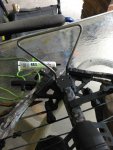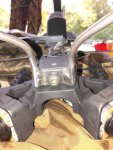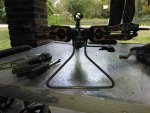bplayer405
Well-known member
- Messages
- 211
- Good Post Points
- 55
Had a friend and fellow hunter call with an issue last night. He took a shot at a doe and missed low. He proceeded to recock his crossbow and the foot stirrup broke and wondered if I could help. He brought it by this morning for me to check out.
The stirrup had some light welds to hold it together, but the material was pretty minimal in thickness to hold back 185 lbs of draw weight to begin with. Two points of attachment roughly 1/8" thick and barely 3/16" wide at close to 90° of torque imposed on these points. Part of the welds failed and what material was left intact snapped off the base.
I cleaned up the base plate then found a length of 1/4" rod and proceeded to bend it up like a small coat hanger. Made some hot solid welds all around the rod's contact with the base and cleaned it up to fit the bow with no problems.
He got the chance this afternoon to try it out and says it works well. He'll paint and plasti-dip the rod section when he gets the chance. Best thing is that he can get back to hunting asap and not have to wait for a replacement part. Love how a bit of ingenuity and welding fab can save the day...


The stirrup had some light welds to hold it together, but the material was pretty minimal in thickness to hold back 185 lbs of draw weight to begin with. Two points of attachment roughly 1/8" thick and barely 3/16" wide at close to 90° of torque imposed on these points. Part of the welds failed and what material was left intact snapped off the base.
I cleaned up the base plate then found a length of 1/4" rod and proceeded to bend it up like a small coat hanger. Made some hot solid welds all around the rod's contact with the base and cleaned it up to fit the bow with no problems.
He got the chance this afternoon to try it out and says it works well. He'll paint and plasti-dip the rod section when he gets the chance. Best thing is that he can get back to hunting asap and not have to wait for a replacement part. Love how a bit of ingenuity and welding fab can save the day...






